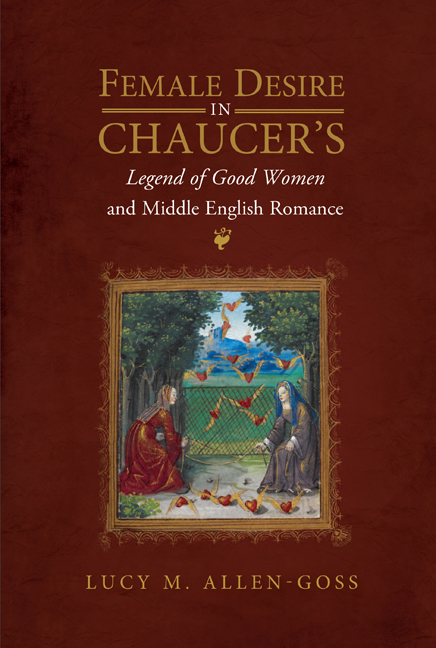Book contents
- Frontmatter
- Contents
- Acknowledgements
- Abbreviations
- Author’s Note
- Introduction: The Origins of Female Desire
- 1 The Silencing of Female Desire in the ‘Legend of Philomela’
- 2 The Traumatised Narrative of the Alliterative Morte Arthure
- 3 ‘As Matter Appetiteth Form’: Desire and Reciprocation in the ‘Legend of Hipsiphyle and Medea’
- 4 Stony Femininity and the Limits of Desire in The Sowdone of Babylon
- 5 Veiled Interpretations and Architectures of Desire in the ‘Legend of Thisbe’ and the ‘Legend of Ariadne’
- 6 Opening Mechanisms, Enclosing Desire: The Erotic Aesthetics of Undo Your Door
- Conclusion: The Ends of Desire
- Bibliography
- Index
- GENDER IN THE MIDDLE AGES
5 - Veiled Interpretations and Architectures of Desire in the ‘Legend of Thisbe’ and the ‘Legend of Ariadne’
Published online by Cambridge University Press: 16 September 2020
- Frontmatter
- Contents
- Acknowledgements
- Abbreviations
- Author’s Note
- Introduction: The Origins of Female Desire
- 1 The Silencing of Female Desire in the ‘Legend of Philomela’
- 2 The Traumatised Narrative of the Alliterative Morte Arthure
- 3 ‘As Matter Appetiteth Form’: Desire and Reciprocation in the ‘Legend of Hipsiphyle and Medea’
- 4 Stony Femininity and the Limits of Desire in The Sowdone of Babylon
- 5 Veiled Interpretations and Architectures of Desire in the ‘Legend of Thisbe’ and the ‘Legend of Ariadne’
- 6 Opening Mechanisms, Enclosing Desire: The Erotic Aesthetics of Undo Your Door
- Conclusion: The Ends of Desire
- Bibliography
- Index
- GENDER IN THE MIDDLE AGES
Summary
Of the ‘goode women’ Chaucer includes in his Legend, two of the most obviously blameless and innocent are Thisbe, heroine of the second tale, and Ariadne, protagonist (or co-protagonist, as she shares all but the title of her tale with her more savvy and ultimately luckier-in-love sister, Phaedra) of the sixth. Neither woman is particularly notorious prior to the Legend. In neither case might Chaucer claim the need to excise a gory narrative of revenge or infanticide (as in the cases of Philomela and Medea), or of conspicuous aggression towards men (as in the case of Hipsyphyle). Yet these legends offer rich sites for Chaucer's ongoing project of interrogating the implications of considering female desire as an active, or even authorial, impulse. The ‘Legend of Thisbe’ shatters convention, featuring a disconcertingly feminised Pyramus, a decidedly dissident Thisbe, and a supporting cast of oddly gendered objects and animals. The retelling undermines the Latin hermeneutic tradition of correlating grammatical structures with sexual and gendered hierarchies of behaviour, taking as its target no less an authority than St Jerome himself. It ends in a moment of remarkably transgressive feminine authority, as Thisbe constructs a text, a ‘compleynte’, from raw material she takes from her lover's supine body. Yet this seeming autonomy is all too soon curtailed, both by Chaucer's bitingly ironic reconfiguring of images from Thisbe's tale in his later ‘Wife of Bath's Prologue’ and, closer to home, in the ‘Legend of Ariadne’, which offers a crudely inverted reworking of the same tropes, now deployed only to demonstrate the sexual and semantic incapability of female desire to shape or structure its chosen subjects. The ‘Legend of Ariadne’ participates in the Legend's persistent imagery of prosthesis, but whereas for Philomela the prosthesis is a marker of female sexual deviancy and for Medea, the indication of an aberrantly feminine body, for Ariadne (whose legend offers the closing word on the matter she shares with Thisbe), prosthesis is a marker of lack, an indication of definitive feminine inability to make meaning. Together, these texts expose the hopelessness of the project that began with Philomela's textile communication and Medea's attempts to construct a linguistic phallus: the impossibility of female subjects taking control of a masculinised language.
- Type
- Chapter
- Information
- Publisher: Boydell & BrewerPrint publication year: 2020



